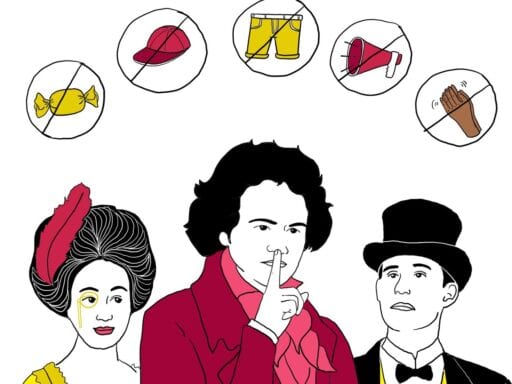To many, Beethoven’s most famous work is a symbol of exclusion and elitism in classical music.
Beethoven’s Fifth Symphony starts with an anguished opening theme — dun dun dun DUNNNN — and ends with a glorious, major-key melody. Since its 1808 premiere, audiences have interpreted that progression from struggle to victory as a metaphor for Beethoven’s personal resilience in the face of his oncoming deafness.
Or rather, that’s long been the popular read among wealthy white men who embraced Beethoven and turned his symphony into a symbol of their superiority and importance. For others — women, LGBTQ+ people, people of color — Beethoven’s symphony is predominantly a reminder of classical music’s history of exclusion and elitism. One New York City classical music fan wrote in the 1840s, for example, that he wished that “all women shall be gagged by officers duly licensed for the purpose before they’re allowed to enter a concert room.”
Today, some aspects of classical culture are still about policing who’s in and who’s out, and it all started with Beethoven’s Fifth. When you walk into a conventional concert hall, there’s an established set of conventions and etiquette (“don’t cough!”; “don’t cheer!”; “dress appropriately!”) that’s more about demonstrating belonging than appreciating the music.
How did we get here? In the third episode of our four-part series The 5th, a collaboration between Vox’s Switched on Pop and the New York Philharmonic that breaks down the music and meaning of this inescapable work of music, we ask how Beethoven’s symphony was transformed from a symbol of triumph and freedom into a symbol of exclusion, elitism, and gatekeeping — everything we love to hate about classical music today. How did the meaning of this symphony get so twisted?
For classical music critic James Bennett II, Beethoven’s popularity and centrality in classical culture is part of the problem. “As you perpetuate the idea that the giants of the music all look the same, it conveys to the other that there’s not a stake in that music for them,” he says.
New York Philharmonic clarinetist Anthony McGill, one of the few Black musicians in the ensemble, agrees that Beethoven’s inescapability makes classical music appear monolithic and stifling. He likens the inescapability of the Fifth Symphony to a “wall” between classical music and new, diverse audiences.
“If you pretend like there’s no other music out there, that Beethoven is the greatest music that ever will matter,” says McGill, then orchestras will alienate new listeners, since “we’re not promoting any of the composers alive today that are trying to become the Beethovens of their day.”
Find out how Beethoven’s Fifth went from a symbol of freedom to one of exclusion — and how the symphony’s original meaning might be recovered — in Movement III of The 5th, available now.
Subscribe to Switched on Pop wherever you find podcasts, including Apple Podcasts, Google Podcasts, Spotify, and Stitcher.
Help keep Vox free for all
Millions turn to Vox each month to understand what’s happening in the news, from the coronavirus crisis to a racial reckoning to what is, quite possibly, the most consequential presidential election of our lifetimes. Our mission has never been more vital than it is in this moment: to empower you through understanding. But our distinctive brand of explanatory journalism takes resources. Even when the economy and the news advertising market recovers, your support will be a critical part of sustaining our resource-intensive work. If you have already contributed, thank you. If you haven’t, please consider helping everyone make sense of an increasingly chaotic world: Contribute today from as little as $3.
Author: Nate Sloan
Read More



